Acoustic Stimulation by Shunt-Diode Pre-Linearizer Using Very High Frequency Piezoelectric Transducer for Cancer Therapeutics
Abstract
1. Introduction
2. Materials and Methods
3. Results and Discussion
3.1. Experimental Performance Verification of the PA with Shunt-diode Pre-linearizer
3.2. Performance Verifications of the Pulse-echo Response
3.3. Quantitative Analysis of PSRs for the HeLa Cell Subsequent Acoustic Stimulation
4. Conclusions
Author Contributions
Funding
Conflicts of Interest
References
- Qiu, W.; Wang, X.; Chen, Y.; Fu, Q.; Su, M.; Zhang, L.; Xia, J.; Dai, J.; Zhang, Y.; Zheng, H. A Modulated Excitation Imaging System for Intravascular Ultrasound. IEEE Trans. Biomed. Eng. 2016, 64, 1935–1942. [Google Scholar] [CrossRef] [PubMed]
- Shung, K.K. Diagnostic Ultrasound: Imaging and Blood Flow Measurements; Taylor & Francis: Boca Raton, FL, USA, 2015. [Google Scholar]
- Li, X.; Wei, W.; Zhou, Q.; Shung, K.K.; Chen, Z. Intravascular photoacoustic imaging at 35 and 80 MHz. J. Biomed. Opt. 2012, 17, 106005. [Google Scholar] [CrossRef]
- Brown, T. Design of medical ultrasonic equipment. Ultrasonics 1968, 6, 107–111. [Google Scholar] [CrossRef]
- Wood, A.K.; Sehgal, C.M. A review of low-intensity ultrasound for cancer therapy. Ultrasound Med. Biol. 2015, 41, 905–928. [Google Scholar] [CrossRef] [PubMed]
- Hwang, J.Y.; Lee, N.S.; Lee, C.; Lam, K.H.; Kim, H.H.; Woo, J.; Lin, M.Y.; Kisler, K.; Choi, H.; Zhou, Q.; et al. Investigating contactless high frequency ultrasound microbeam stimulation for determination of invasion potential of breast cancer cells. Biotechnol. Bioeng. 2013, 110, 2697–2705. [Google Scholar] [CrossRef]
- Kremkau, F.W. Cancer therapy with ultrasound: a historical review. J. Clin. Ultrasound 1979, 7, 287–300. [Google Scholar] [CrossRef] [PubMed]
- Corry, P.M.; Jabboury, K.; Armour, E.P.; Kong, J.S. Human cancer treatment with ultrasound. IEEE Trans. Sonics Ultrason. 1984, 31, 444–456. [Google Scholar] [CrossRef]
- Wang, X.B.; Liu, Q.H.; Mi, N.; Wang, P.; Tang, W.; Zhao, X.H.; Li, X.J. Sonodynamically induced apoptosis by protoporphyrin IX on hepatoma-22 cells in vitro. Ultrasound Med. Biol. 2010, 36, 667–676. [Google Scholar] [CrossRef]
- Ter Haar, G. Therapeutic applications of ultrasound. Prog. Biophys. Mol. Biol. 2007, 93, 111–129. [Google Scholar] [CrossRef]
- Yoshida, T.; Kondo, T.; Ogawa, R.; Feril, L.B.; Zhao, Q.-L.; Watanabe, A.; Tsukada, K. Combination of doxorubicin and low-intensity ultrasound causes a synergistic enhancement in cell killing and an additive enhancement in apoptosis induction in human lymphoma U937 cells. Cancer Chemother. Pharmacol. 2008, 61, 559–567. [Google Scholar] [CrossRef]
- He, Z.; Zheng, F.; Ma, Y.; Kim, H.H.; Zhou, Q.; Shung, K.K. A sidelobe suppressing near-field beamforming approach for ultrasound array imaging. J. Acoust. Soc. Am. 2015, 137, 2785–2790. [Google Scholar] [CrossRef] [PubMed]
- Zhou, Q.; Lau, S.; Wu, D.; Shung, K.K. Piezoelectric films for high frequency ultrasonic transducers in biomedical applications. Prog. Mater. Sci. 2011, 56, 139–174. [Google Scholar] [CrossRef] [PubMed]
- Szabo, T.L. Diagnostic Ultrasound Imaging: Inside Out; Elsevier Academic Press: London, UK, 2013. [Google Scholar]
- Weibao, Q.; Yanyan, Y.; Fu Keung, T.; Lei, S. A multifunctional, reconfigurable pulse generator for high-frequency ultrasound imaging. IEEE Trans. Ultrason. Ferroelectr. Freq. Control 2012, 59, 1558–1567. [Google Scholar] [CrossRef]
- Zhu, B.; Xu, J.; Li, Y.; Wang, T.; Xiong, K.; Lee, C.; Yang, X.; Shiiba, M.; Takeuchi, S.; Zhou, Q. Micro-particle manipulation by single beam acoustic tweezers based on hydrothermal PZT thick film. AIP Adv. 2016, 6, 035102. [Google Scholar] [CrossRef] [PubMed]
- Kazimierczuk, M.K. RF Power Amplifier; John Wiley & Sons: Hoboken, NJ, USA, 2014. [Google Scholar]
- Vuolevi, J.; Rahkonen, T. Distortion in RF Power Amplifiers; Artech House: London, UK, 2003. [Google Scholar]
- Gao, Z.; Gui, P. A look-up-table digital predistortion technique for high-voltage power amplifiers in ultrasonic applications. IEEE Trans. Ultrason. Ferroelectr. Freq. Control 2012, 59, 1550–1557. [Google Scholar]
- Liu, W.-W.; Liu, S.-W.; Liou, Y.-R.; Wu, Y.-H.; Yang, Y.-C.; Wang, C.-R.C.; Li, P.-C. Nanodroplet-Vaporization-Assisted Sonoporation for Highly Effective Delivery of Photothermal Treatment. Sci. Rep. 2016, 6, 24753. [Google Scholar] [CrossRef] [PubMed]
- Kirkhorn, J.; Frinking, P.J.; de Jong, N.; Torp, H. Three-stage approach to ultrasound contrast detection. IEEE Trans. Ultrason. Ferroelectr. Freq. Control 2001, 48, 1013–1022. [Google Scholar] [CrossRef]
- Zwiebel, W.J.; Pellerito, J.S. Introduction to Vascular Ultrasonography; Elsevier Saunders: Philadelphia, PA, USA, 2005. [Google Scholar]
- Kremkau, F.W.; Forsberg, F. Sonography Principles and Instruments; Elsevier Health Sciences: Amsterdam, The Netherlands, 2015. [Google Scholar]
- Shung, K.K.; Smith, M.; Tsui, B.M. Principles of Medical Imaging; Academic Press: Cambridge, MA, USA, 2012. [Google Scholar]
- Hynynen, K. Demonstration of enhanced temperature elevation due to nonlinear propagation of focussed ultrasound in dog’s thigh in vivo. Ultrasound Med. Biol. 1987, 13, 85–91. [Google Scholar] [CrossRef]
- Filonenko, E.; Khokhlova, V. Effect of acoustic nonlinearity on heating of biological tissue by high-intensity focused ultrasound. Acoust. Phys. 2001, 47, 468–475. [Google Scholar] [CrossRef]
- Lam, K.H.; Li, Y.; Li, Y.; Lim, H.G.; Zhou, Q.; Shung, K.K. Multifunctional single beam acoustic tweezer for non-invasive cell/organism manipulation and tissue imaging. Sci. Rep. 2016, 6, 37554. [Google Scholar] [CrossRef]
- Cripps, S.C. RF Power Amplifiers for Wireless Communications; Artech House: Norwood, MA, USA, 2006. [Google Scholar]
- Neamen, D.A. Semiconductor Physics and Devices; McGraw-Hill: New York, NY, USA, 1997. [Google Scholar]
- Lam, K.H.; Hsu, H.S.; Li, Y.; Lee, C.; Lin, A.; Zhou, Q.; Kim, E.S.; Shung, K.K. Ultrahigh frequency lensless ultrasonic transducers for acoustic tweezers application. Biotechnol. Bioeng. 2013, 110, 881–886. [Google Scholar] [CrossRef] [PubMed]
- Minasian, R.A. Power MOSFET dynamic large-signal model. IEE Proc. I Solid-State Electron Device 1983, 130, 73–79. [Google Scholar] [CrossRef]
- Albulet, M. RF Power Amplifiers; SciTech Publishing: London, UK, 2001. [Google Scholar]
- Lee, T.H. The Design of CMOS Radio-Frequency Integrated Circuits; Cambridge University Press: Cambridge, UK, 2006. [Google Scholar]
- Cripps, S.C. Advanced Techniques in RF Power Amplifier Design; Artech House: Norwood, MA, USA, 2002. [Google Scholar]
- Jeong, J.J.; Choi, H. An impedance measurement system for piezoelectric array element transducers. Measurement 2017, 97, 138–144. [Google Scholar] [CrossRef]
- Choi, H.; Woo, P.C.; Yeom, J.-Y.; Yoon, C. Power MOSFET Linearizer of a High-Voltage Power Amplifier for High-Frequency Pulse-Echo Instrumentation. Sensors 2017, 17, 764. [Google Scholar] [CrossRef]
- Yu, T. A review of research into the uses of low level ultrasound in cancer therapy. Ultrason. Sonochem. 2004, 11, 95–103. [Google Scholar] [CrossRef]
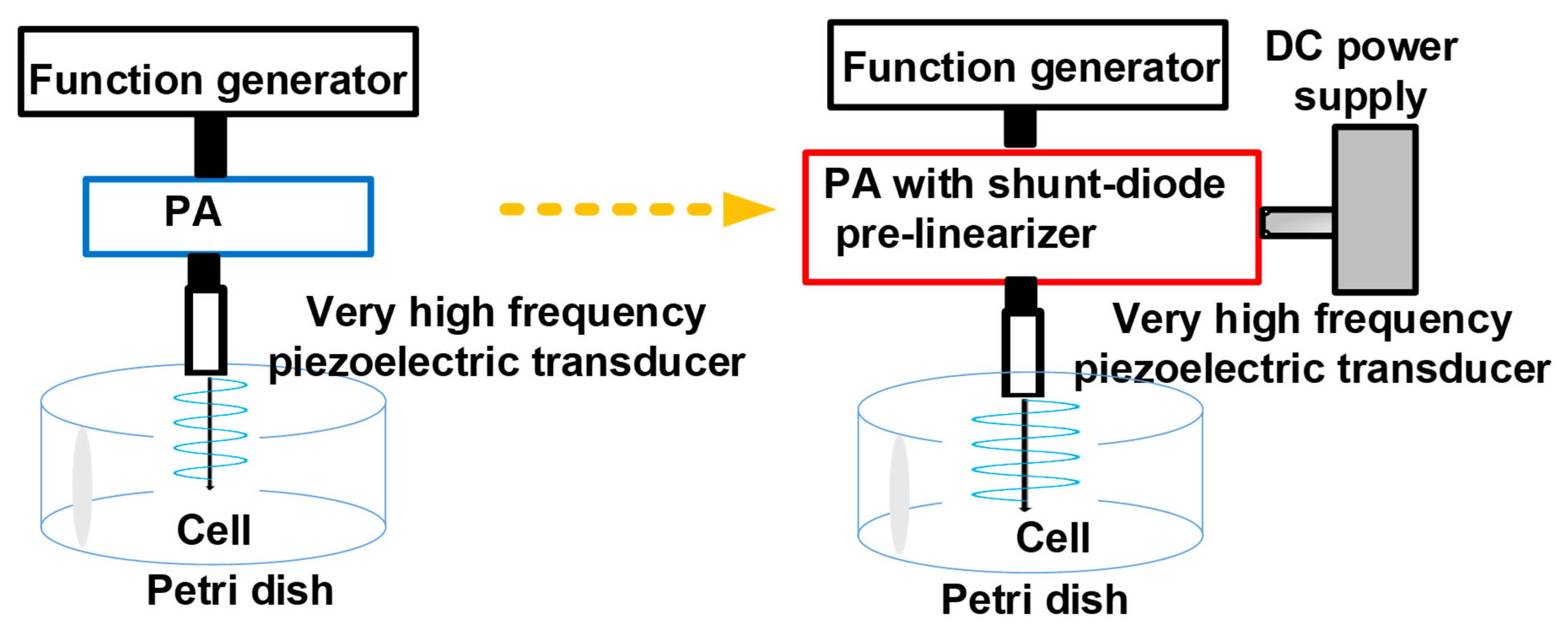


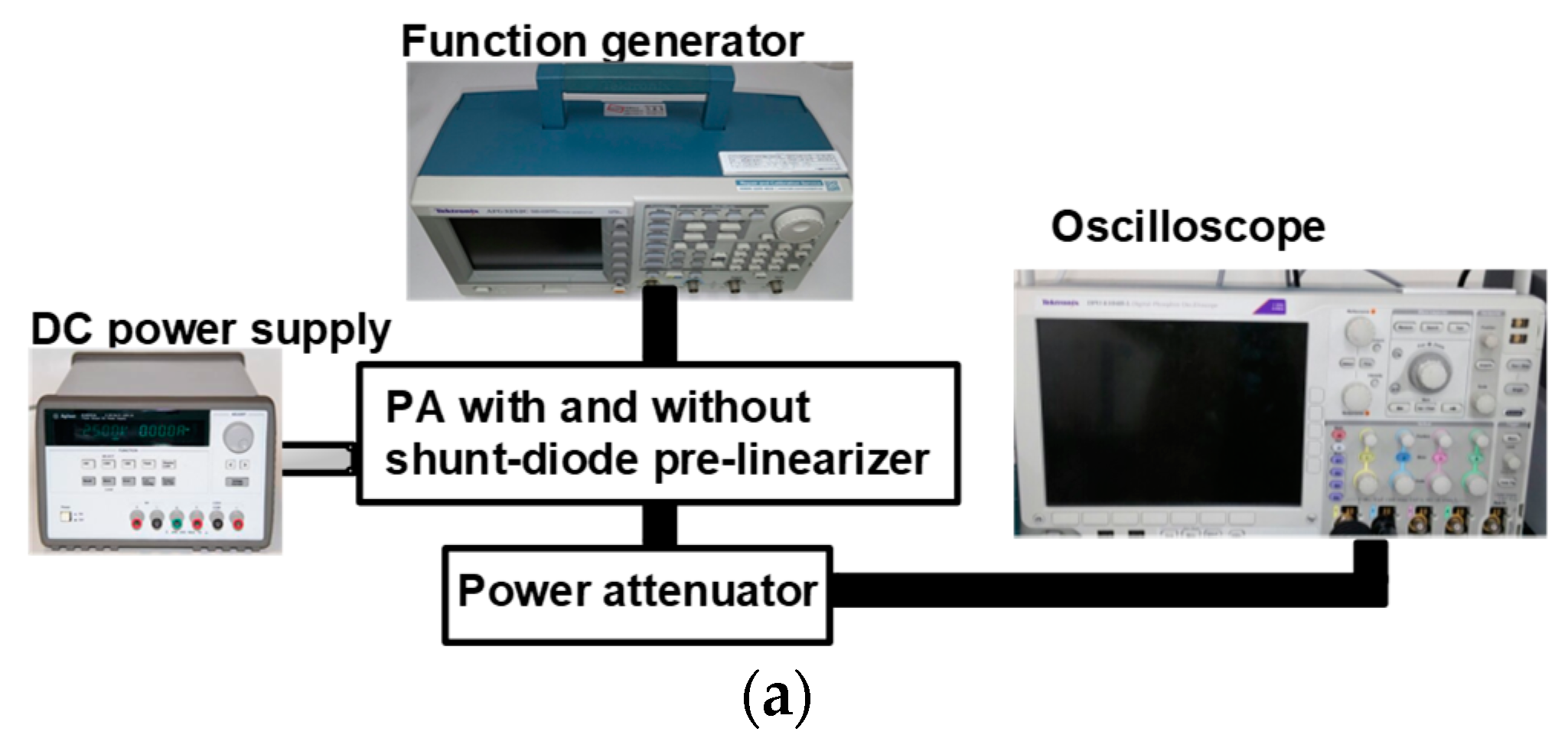
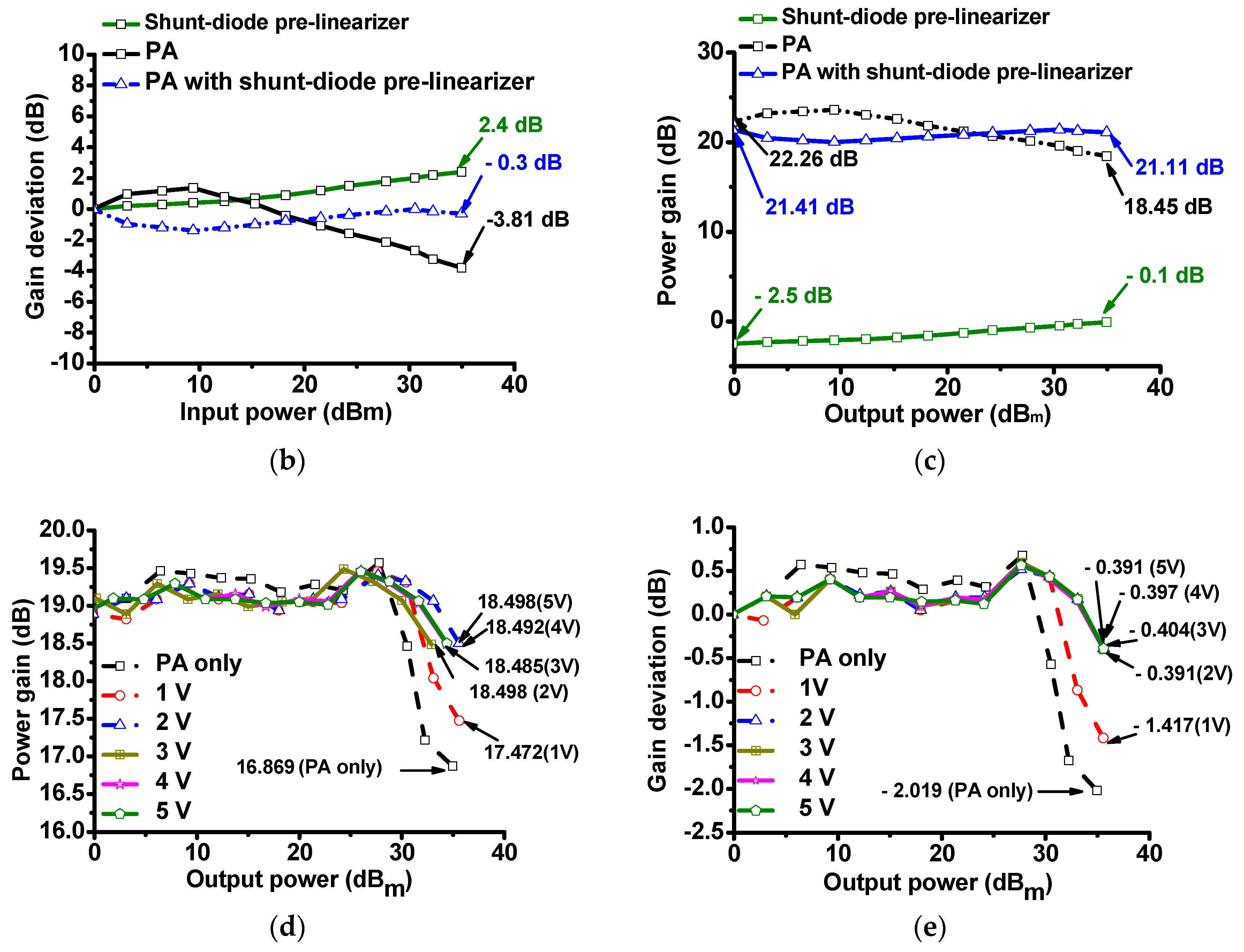
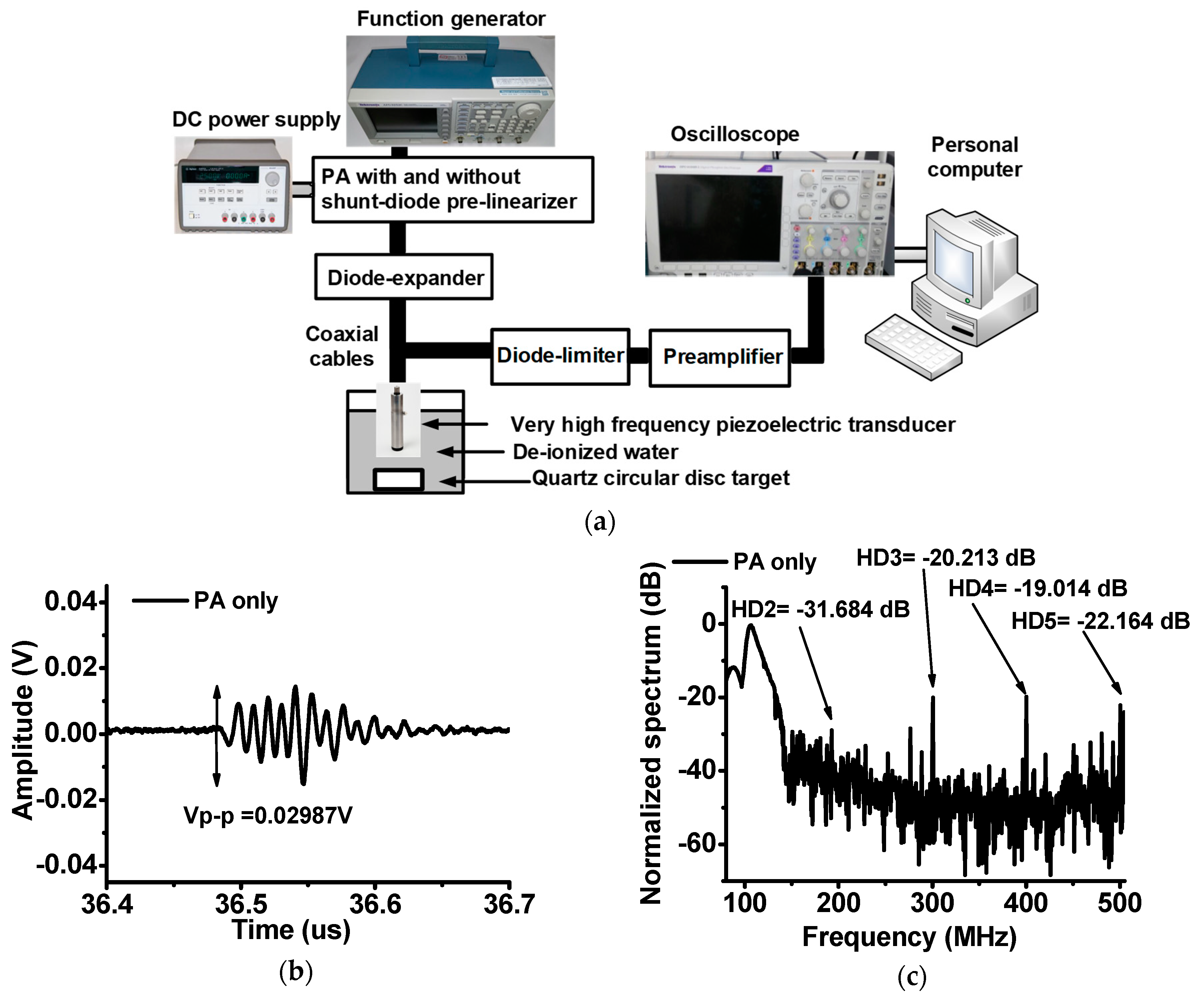

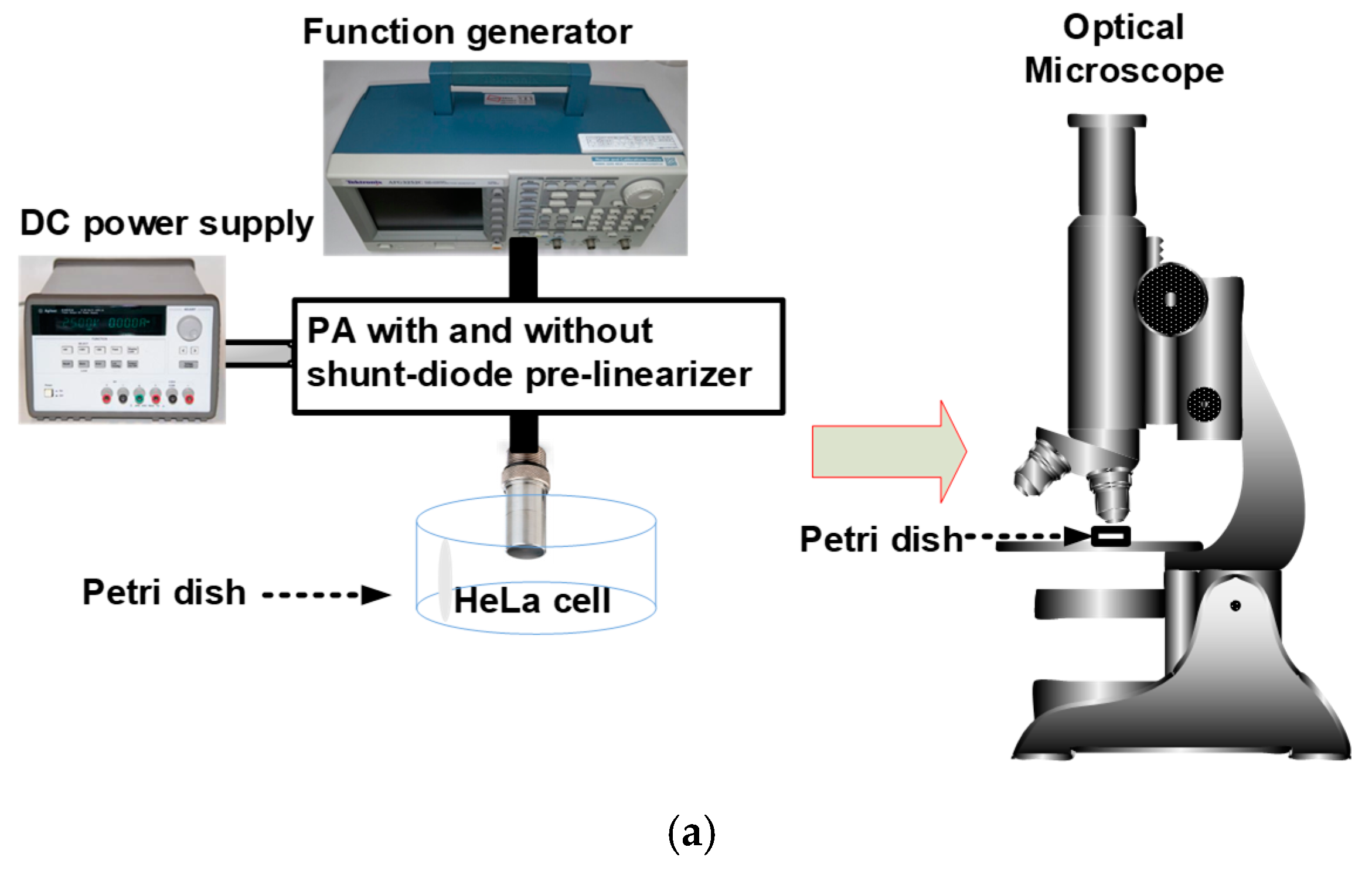
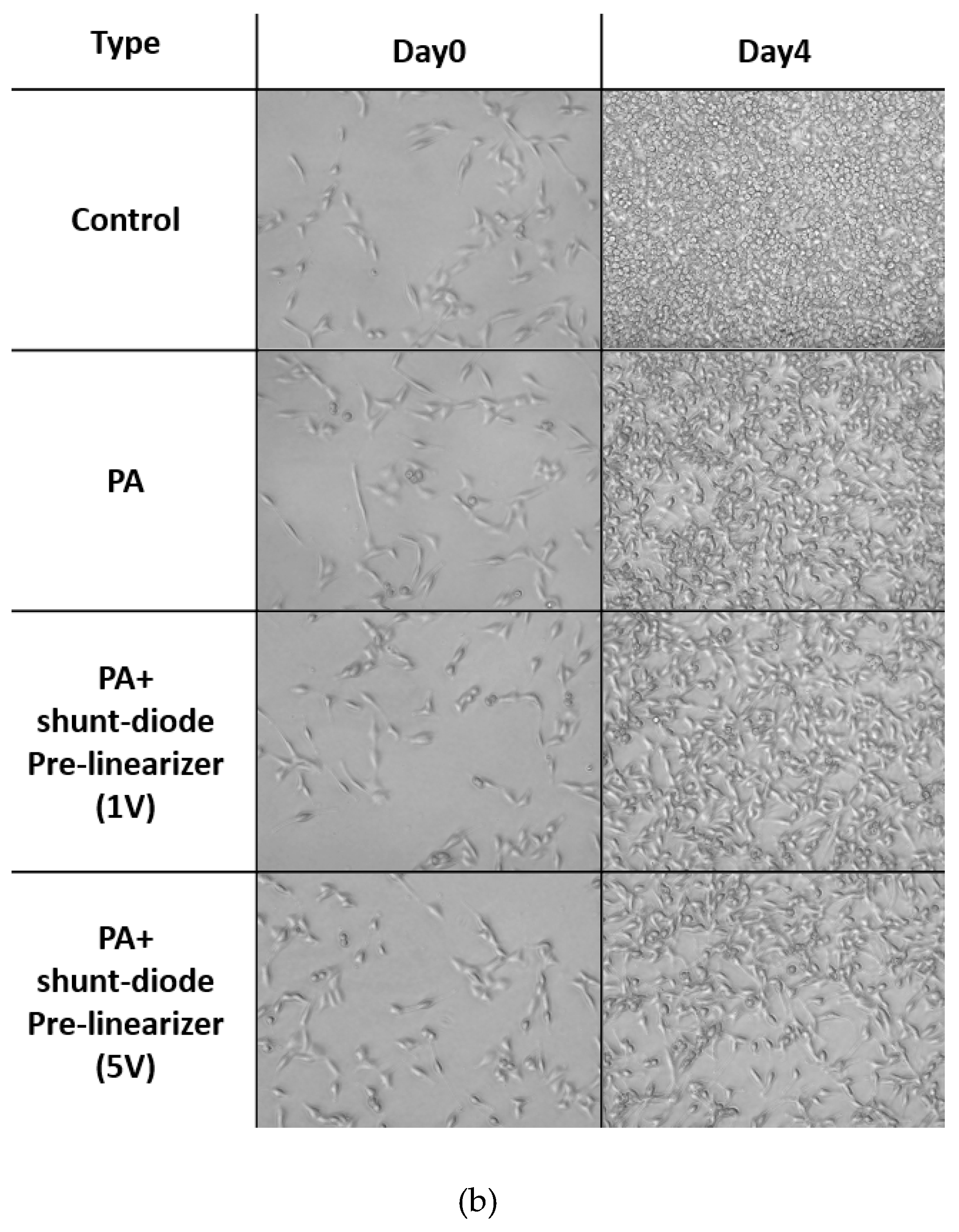
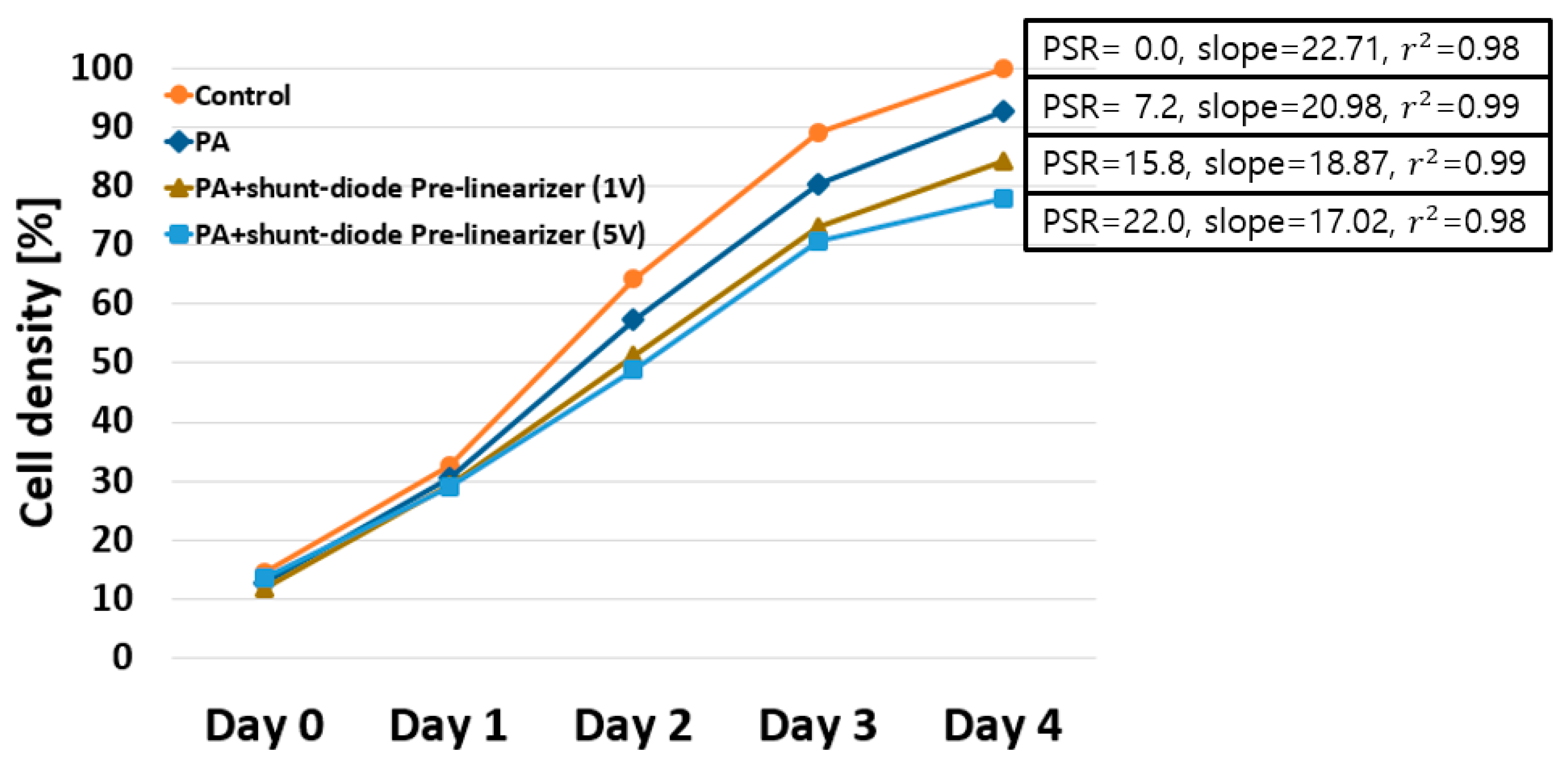
| PA only | 1 V | 2 V | 3 V | 4 V | 5 V | |
|---|---|---|---|---|---|---|
| Amplitudes | 0.02987 | 0.03575 | 0.04925 | 0.04821 | 0.04766 | 0.04979 |
| HD2 (dB) | −31.684 | −31.655 | −36.452 | −35.924 | −37.125 | −36.442 |
| HD3 (dB) | −20.213 | −19.950 | −24.331 | −25.116 | −25.881 | −24.562 |
| HD4 (dB) | −19.014 | −24.450 | −28.988 | −30.845 | −29.125 | −29.871 |
| HD5 (dB) | −22.164 | −22.486 | −29.441 | −28.114 | −28.514 | −27.486 |
| THD (dB) | −30.806 | −33.966 | −44.320 | −44.561 | −45.341 | −43.689 |
| Day 0 | Day 1 | Day 2 | Day 3 | Day 4 | PSR (vs. Control) | Slope | r2 | |
|---|---|---|---|---|---|---|---|---|
| Control | 14.7 ± 3.8% | 32.7 ± 2.6% | 64.2 ± 3.8% | 89.2 ± 3.7% | 100 ± 0.0% | 0% | 22.71 | 0.98 |
| PA only | 12.8 ± 3.2% | 30.6 ± 5.1% | 57.4 ± 5.8% | 80.4 ± 4.0% | 92.8 ± 4.2% | 7.2% | 20.98 | 0.99 |
| PA with shunt-diode pre-linearizer at 1V | 11.7 ± 1.4% | 29.3 ± 1.9% | 51.2 ± 4.7% | 73 ± 3.4% | 84.2 ± 4.6% | 15.8% | 18.87 | 0.99 |
| PA with shunt-diode pre-linearizer at 5V | 13.7 ± 1.1% | 29.1 ± 1.1% | 49.0 ± 5.7% | 70.8 ± 3.7% | 78.0 ± 2.9% | 22.0% | 17.02 | 0.98 |
© 2019 by the authors. Licensee MDPI, Basel, Switzerland. This article is an open access article distributed under the terms and conditions of the Creative Commons Attribution (CC BY) license (http://creativecommons.org/licenses/by/4.0/).
Share and Cite
Choi, H.; Choe, S.-w. Acoustic Stimulation by Shunt-Diode Pre-Linearizer Using Very High Frequency Piezoelectric Transducer for Cancer Therapeutics. Sensors 2019, 19, 357. https://doi.org/10.3390/s19020357
Choi H, Choe S-w. Acoustic Stimulation by Shunt-Diode Pre-Linearizer Using Very High Frequency Piezoelectric Transducer for Cancer Therapeutics. Sensors. 2019; 19(2):357. https://doi.org/10.3390/s19020357
Chicago/Turabian StyleChoi, Hojong, and Se-woon Choe. 2019. "Acoustic Stimulation by Shunt-Diode Pre-Linearizer Using Very High Frequency Piezoelectric Transducer for Cancer Therapeutics" Sensors 19, no. 2: 357. https://doi.org/10.3390/s19020357
APA StyleChoi, H., & Choe, S.-w. (2019). Acoustic Stimulation by Shunt-Diode Pre-Linearizer Using Very High Frequency Piezoelectric Transducer for Cancer Therapeutics. Sensors, 19(2), 357. https://doi.org/10.3390/s19020357






